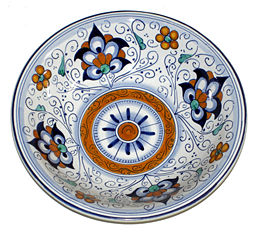Faience
- For the architectural material, see Glazed architectural terra-cotta. For the ceramics of Ancient Egypt and the Indus Valley, see Egyptian faience
Faience or faïence is the conventional name in English for fine tin-glazed earthenware on a delicate pale buff body. The invention of a pottery glaze suitable for painted decoration, by the addition of an oxide of tin to the slip of a lead glaze, was a major advance in the history of pottery. The invention seems to have been made in Iran or the Middle East before the ninth century. A kiln capable of producing temperatures exceeding 1000° C was required to achieve this result (see pottery), the result of millennia of refined pottery-making traditions.
Technically, lead-glazed earthenware, such as the French sixteenth-century Saint-Porchaire ware, does not properly qualify as faience, but the distinction is not usually maintained.
Ancient "faience"
- Main article Egyptian faience.
The term "faience" has been extended to include finely glazed ceramic beads found in Egypt as early as 4000 B.C.E. and at sites in the Indus Valley Civilization.
Faience in the Western Mediterranean
The Moors brought the technique of tin-glazed earthenware to Al-Andalus, where the art of metallic glazes was perfected. From Andalusia it was exported, either directly or via the Balearic Islands[1] to Italy. In Italy, locally produced tin-glazed earthenwares, initiated in the fourteenth century, reached a peak in the late fifteenth and early sixteenth centuries, represented by the Italian faience called Majolica. The name faience is simply the French name for Faenza, in the Romagna near Ravenna, Italy, where a painted majolica ware on a clean, opaque pure-white ground, was produced for export as early as the fifteenth century.
"Majolica" (pronounced and also spelled "maiolica") is a garbled version of "Maiorica", for the island of Majorca, which was a transshipping point for refined tin-glazed earthenwares shipped to Italy from the kingdom of Aragon in Spain at the close of the Middle Ages. This type of Spanish pottery owed much to its Moorish inheritance.
French and northern European faïence
The first northerners to imitate the tin-glazed earthenwares being imported from Italy were the Dutch. Delftware is a kind of faience, made at potteries round Delft in Holland, characteristically decorated in blue on white, in imitation of the blue-and-white porcelain that was imported from China in the early sixteenth century, but it quickly developed its own recognisably Dutch décor.
Dutch potters in northern (and Protestant) Germany established German centres of faience: the first manufactories in Germany were opened at Hanau (1661) and Heusenstamm (1662), soon moved to nearby Frankfurt-am-Main.
In France, centres of faience manufacturing developed from the early eighteenth century led in 1690 by Quimper in Brittany [1], which today possesses an interesting museum devoted to faience, and followed by Rouen, Strasbourg and Lunéville.
The products of faience manufactories, rarely marked, are identified by the usual methods of ceramic connoisseurship: the character of the body, the character and palette of the glaze, and the style of decoration, faïence blanche being left in its undecorated fired white slip. Faïence parlante bears mottoes often on decorative labels or banners. Wares for apothecary use bear the names of their intended contents, generally in Latin and often so abbreviated to be unrecognizable to the untutored eye. Mottoes of fellowships and associations became popular in the 18th century, leading to the Faïence patriotique that was a specialty of the years of the French Revolution.
In the course of the later 18th century, cheap porcelain took over the market for refined faience; in the early 19th century, fine stoneware—fired so hot that the unglazed body vitrifies—closed the last of the traditional makers' ateliers even for beer steins. At the low end of the market, local manufactories continued to supply regional markets with coarse and simple wares.
Faïence revival
In the 1870s, the Aesthetic movement, notably in Britain, rediscovered the robust charm of faience, and the large porcelain manufactories marketed revived faience, such as the "Majolica ware" of Minton and of Wedgwood.
Many centres of traditional manufacture are recognized, even some individual ateliers. A partial list follows.
England
- Faience fine (imported into France)
France
- Aprey faience
- Gien faience
- Lyon faience
- Lunéville faience
- Marseille faience
- Moustiers faience
- Nevers faience
- Quimper faience
- Saint-Porchaire ware, for comparison
Germany
- Abtsbessingen faience
- Nürnberg faience
- Öttingen–Schrattenhofen faience
- Schleswig faience
- Stockelsdorf faience - de:Stockelsdorfer Fayencemanufaktur
- Stralsund faience - de:Stralsunder Fayencenmanufaktur
Links
Italy
- Savona faience
- Turin faience
- Aluminia faience (Denmark)
- Rörstrand faience (Sweden)
- Strålsund faience (Sweden, closed 1792)
Notes
- ↑ "Majolica" derives from Majorca, an early depot for the re-export of tin-glazed earthenware to Italy
On-line bibliographic references
Credits
New World Encyclopedia writers and editors rewrote and completed the Wikipedia article in accordance with New World Encyclopedia standards. This article abides by terms of the Creative Commons CC-by-sa 3.0 License (CC-by-sa), which may be used and disseminated with proper attribution. Credit is due under the terms of this license that can reference both the New World Encyclopedia contributors and the selfless volunteer contributors of the Wikimedia Foundation. To cite this article click here for a list of acceptable citing formats.The history of earlier contributions by wikipedians is accessible to researchers here:
The history of this article since it was imported to New World Encyclopedia:
Note: Some restrictions may apply to use of individual images which are separately licensed.


